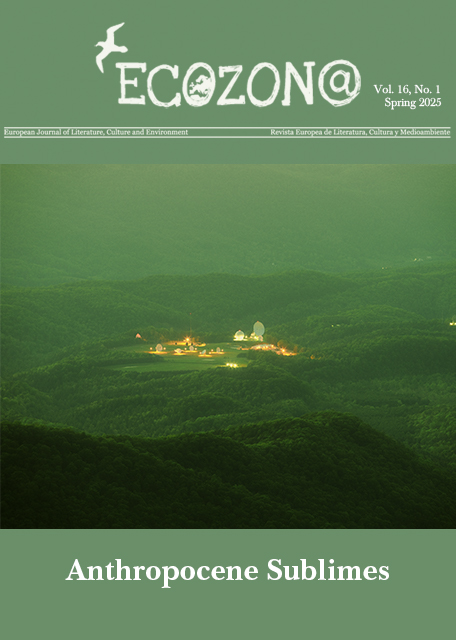<b>Tolkien’s Sonic Trees and Perfumed Herbs: Plant Intelligence in Middle-earth</b> // Los árboles sónicos y las hierbas perfumadas de Tolkien: La inteligencia de las plantas de la Tierra Media
DOI:
https://doi.org/10.37536/ECOZONA.2015.6.2.670Keywords:
J.R.R. Tolkien, Middle-earth, Old Man Willow, athelas, bioacoustics, critical plant studies, Tierra Media, Viejo Hombre Sauce, bioacústica, estudios críticos de la plantaAbstract
Plant life is an integral part of J.R.R. Tolkien’s fictional writings. Percipient trees, exemplified by Old Man Willow, possess the capacity to vocalise and approximate human speech, whereas herbaceous plants tend to be silent and aromatic. While Tolkien attributes qualities of consciousness and memory to sonic trees, he denies similar intelligent qualities to herbs, such as athelas or kingsfoil. This paper will compare the sonic trees and perfumed herbs of Middle-earth through the framework of emerging science in plant bioacoustics and behaviour. A distinction will be made between the extrinsic and intrinsic capacities of plants in the legendarium. Tolkien’s arborescent ethics privileges trees, endowing them with vocalisation, while constructing healing plants in terms of their use value and associating the sense of smell with a non-sentient flora.
Resumen
La vida vegetal es una parte integral de la ficción de J.R.R. Tolkien. Los árboles perceptores, ejemplificados por el Viejo Hombre-Sauce, poseen la capacidad de vocalizar y parecerse al lenguaje humano, mientras que las plantas herbáceas tienden a estar en silencio y ser aromáticas. Aunque Tolkien atribuye cualidades de conciencia y memoria a los árboles sónicos, niega cualidades inteligentes similares a las hierbas, como la athelas u hojas de reyes. En este trabajo se compara la representación de los árboles sónicos y de las hierbas perfumadas de la Tierra Media a través del marco de la ciencia emergente de la bioacústica y el comportamiento de las plantas. La distinción entre las capacidades extrínsecas e intrínsecas de las plantas forma la base de un enfoque más matizado a la inteligencia de las plantas, tanto en la Tierra Media como en el mundo botánico de la experiencia humana cotidiana. La ética arborescente de Tolkien favorece a los árboles, dotándolos de vocalización, mientras que crea plantas sanadoras en función del valor de su uso, asociando el sentido del olfato con la flora no-consciente. Una conceptualización más inclusiva de la inteligencia y la conciencia implica mucha atención a las diversas expresiones sensoriales de los seres vegetales y la naturaleza no humana.
Downloads
Downloads
Published
Issue
Section
License
Authors who publish with this journal agree to the following terms:
a) Authors retain copyright and grant the journal right of first publication with the work simultaneously licensed under a Creative Commons Attribution License that allows others to share the work with an acknowledgement of the work's authorship and initial publication in this journal (CC BY-NC for articles and CC BY-NC-ND for creative work, unless author requests otherwise.
b) Authors are able to enter into separate, additional contractual arrangements for the non-exclusive distribution of the journal's published version of the work (e.g., post it to an institutional repository or publish it in a book), with an acknowledgement of its initial publication in this journal.
c) Authors are permitted and encouraged to post their work online (e.g., in institutional repositories or on their website) prior to and during the submission process, as it can lead to productive exchanges, as well as earlier and greater citation of published work (See The Effect of Open Access).










